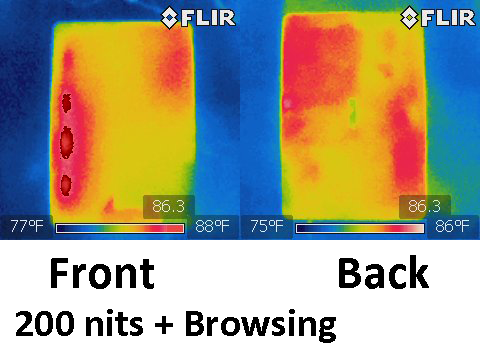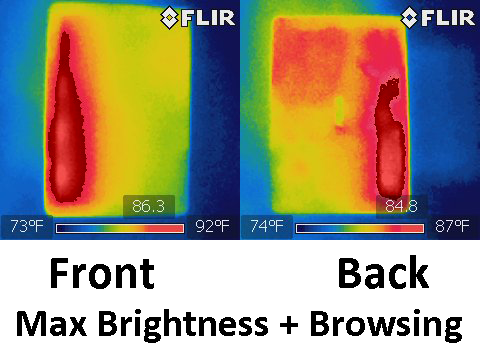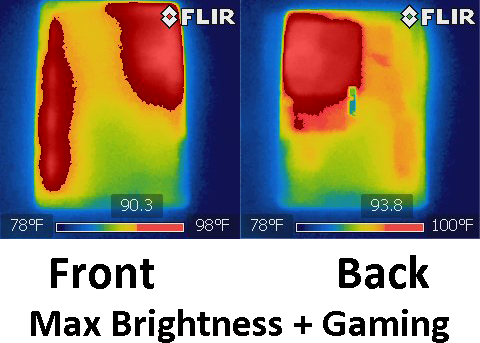Asus Transformer Pad TF300T Review: Tegra 3, More Affordable
Temperature Analysis With A Thermal Camera
Tablets and smartphones are touch-based devices, which means you're going to have a lot of physical contact with them. If you do a lot of gaming on an iPad 3 with its brightness cranked up, the device can get quite hot, making it uncomfortable to hold. On the other hand, we found that Asus' Transformer Prime stayed nice and cool, even under similar loads. Although the TF201's aluminum body created problems for GPS reception, it does a great job of dissipating heat.
The Transformer Pad's plastic doesn't fare quite as well. In the shot below, after browsing the Web for 30 minutes with the display calibrated to 200 nits, the tablet remains relatively cool. Aside from a few warmer spots, the maximum temperature is only 86o F.
Cranking the brightness up to 100% results in a slightly higher surface temperature. If you look closely, the temperature increases along a single edge where the LCD's backlight circuity resides.
Tablets always seem to dissipate the most heat while gaming at maximum brightness. As you can see in the shot below, the Transformer Pad's hot spots get larger, particularly in the upper right-hand corner on the back side of the tablet (naturally, where the Tegra 3 SoC is located). The surface temperature isn't a uniform 100o F; however, this picture shows that Asus' TF300T can still get pretty warm. A plastic body benefits GPS signal reception, but it also acts as a heat insulator.
Get Tom's Hardware's best news and in-depth reviews, straight to your inbox.
Current page: Temperature Analysis With A Thermal Camera
Prev Page HDMI Output And Camera Image Quality Next Page Transformer Pad TF300T: The Most Cost-Effective Tablet-
burnley14 Looks like a great tablet. The screen could use a little work, especially the resolution, but everything else checks out well. I too will be interested to see a tablet like this one running Windows 8, could be a game-changer.Reply -
netadmin "Fortunately, Asus is sticking with $149 as the price for TF300T's complementary accessory."Reply
Maybe it's just me, but I don't see anything fortunate about paying the same price for an inferior product. Based on reviews at other sites, the keyboard dock for the TF300T has a 16 Wh battery compared to the 22 Wh battery for the Prime dock. Is it being suggested that 27% lower battery capacity does not make any difference in price? I understand that ASUS has to make a profit, but would it not be reasonable to lower the price a little bit, at least? -
vicsrealms Looks like a great tablet, but I can't even find the Asus Transformer Prime anywhere. Maybe it the availability is good I may try to manage to pick one up, but i have given up on the Prime.Reply -
halcyon I really would like to see a successor to the Transformer Prime with a display with the same or higher resolution as the 3rd gen iPad. That'd be quite something.Reply -
mobomofo How come no one has pulled the "Does it play Crysis?" yet.Reply
That joke can't die. We gotta keep it alive people.
+2 for the Bakersfield joke. Good eye. -
everygamer Anyone get a PS3 or other mainstream game controller paired with the Transformer via bluetooth without rooting?Reply


